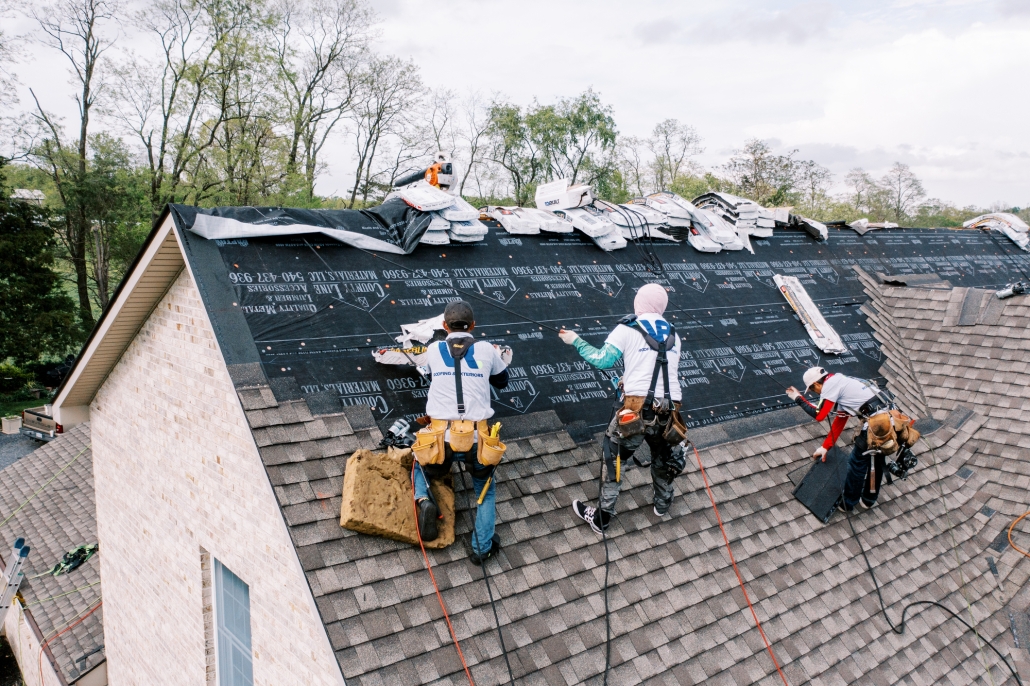The Relevance of Selecting Skilled Roofing Companies Gainesville Florida
The Relevance of Selecting Skilled Roofing Companies Gainesville Florida
Blog Article
Finest Practices for Ensuring Proper Roof Air Flow
Guaranteeing proper roof ventilation is important for the durability and efficiency of a roof. A well balanced consumption and exhaust air vent ratio, frequently 1:300, plays a crucial duty, with intake vents ideally placed at the lower side of the roofing for cool air access and exhaust vents at the top for warm air departure. Regular examinations to determine blockages and preserve clear air flow are vital. Keeping insulation away from vents is essential to stop airflow limitation. Recognizing these fundamental components sets the stage for more thorough understandings right into installation and maintenance methods that can considerably boost your roof's performance.
Understand Ventilation Basics
Appropriately recognizing ventilation essentials is crucial for guaranteeing the longevity and performance of roof. Efficient air flow alleviates wetness accumulation and temperature level extremes in the attic room, both of which can cause significant structural damage in time. A well-ventilated roofing system assists in protecting against usual concerns such as mold and mildew growth, wood rot, and ice dams, which can endanger the integrity of the roof products and the underlying structures.
The primary objective of air flow is to facilitate the activity of air, enabling a constant exchange between the exterior and interior atmospheres. This balance is accomplished through a mix of consumption and exhaust vents that work together to maintain optimal air movement. Consumption vents, generally located along the eaves or soffits, enable fresh air to go into the attic room space, while exhaust vents, typically situated at or near the roofing ridge, make it possible for hot, damp air to leave.
Trick factors influencing the performance of roofing system ventilation include appropriate placement, appropriate sizing, and ensuring that both intake and exhaust vents are unblocked. Regular evaluation and upkeep are essential to recognize prospective obstructions, damages, or ineffectiveness in the air flow system, consequently safeguarding the roofing's performance and longevity.
Sorts Of Roof Vents
Roofing system vents play a vital role in maintaining reliable attic room ventilation and, by extension, the general wellness of the roof system. Numerous types of roof covering vents are readily available, each with distinct benefits tailored to specific roofing demands. Ridge vents, for instance, are mounted along the roof's top, permitting cozy, moist air to get away from the attic room. They provide continuous air flow and blend seamlessly with the roofline, making them both efficient and visually pleasing.

Soffit vents are installed under the eaves and operate in tandem with roofing vents to ensure a balanced intake and exhaust system. By permitting cooler air to enter from below, soffit vents promote the expulsion of hot air with upper vents. Gable vents, situated on the exterior walls of the attic, deal one more reliable option, particularly in homes with gable roofs.
Evaluate Your Current Air Flow

Following, consider the age and problem of your roofing products and air flow elements. Older systems might not abide by present building regulations or might have worn away gradually, decreasing their performance. Conduct an extensive evaluation to identify any kind of signs of damage, such as corrosion, damages, or gaps that can jeopardize the system's performance.
Furthermore, determine the attic room temperature level and humidity levels. High temperature levels and humidity can suggest insufficient air flow.
Installation Best Practices
Effective setup of roof covering ventilation systems is critical for ensuring ideal performance and durability. Correct installation starts with recognizing the certain ventilation needs of the roof covering and the building it covers. This involves calculating the right ratio of intake to wear down vents, typically sticking to the 1:300 regulation, which states one square foot of ventilation for each 300 square feet of attic floor room.

Consumption vents must be mounted at the roofing's reduced edge, often in the soffits, to permit awesome air to get in. Exhaust vents, on the other hand, ought to be installed near or at the roofing system's top to facilitate the departure of warm, moist air.
Seal all air vent links meticulously to avoid air leakages and potential water seepage. Use top notch materials and comply with maker standards to make sure durability and effectiveness. Furthermore, incorporating ridge vents with baffles can significantly enhance air flow performance by preventing wind-driven rainfall and snow from going into the attic room.
Eventually, exact setup of roof air flow systems alleviates possible problems such as mold and mildew growth, ice dams, and structural damage, ensuring the roof's stability and the building's overall health and wellness.
Regular Upkeep Tips
Consistency in upkeep techniques is essential to making sure the long-lasting efficiency of roof air flow systems. Throughout these examinations, ensure that vents are complimentary of debris, nests, useful link and other blockages that might hinder air movement.
Use a soft brush or a vacuum cleaner to get rid of dirt and debris from intake and exhaust vents. Be careful not to harm the air vent displays or louvers during the procedure.
Correct insulation is similarly crucial. Make sure that attic insulation does not internet block the vents, as this can seriously limit air flow. If any type of insulation has moved or worked out, reposition or change it to preserve a reliable obstacle.
Last but not least, replace any damaged or missing out on parts promptly. Busted vents, cracked roof shingles, or tatty blinking can all contribute to poor ventilation and needs to be resolved immediately. Routine maintenance makes certain that the roofing air flow system functions ideally, consequently expanding the lifespan of the roofing system itself.
Verdict
Ensuring correct roofing air flow is vital for preserving the performance and durability of a roof. Adherence to the 1:300 consumption and exhaust air vent proportion, paired with the strategic positioning of vents, is vital. Routine biannual evaluations, debris cleansing, and making sure insulation does not obstruct air movement are important techniques. Executing these best techniques will certainly cultivate a well-ventilated roof covering system, thus minimizing potential issues associated with moisture buildup and extreme warmth, eventually lengthening the roofing system's lifespan.
A balanced intake and exhaust vent proportion, generally 1:300, plays a crucial role, with consumption vents preferably put at the reduced side of the roof for great air entrance and exhaust vents at the peak for warm air departure. Intake vents, normally situated along the soffits or eaves, permit fresh air to get in the attic room area, while exhaust vents, frequently situated at or near the roof covering ridge, enable warm, moist air to run away.
Soffit vents are set up under the eaves and work in recommended you read tandem with roof covering vents to ensure a balanced intake and exhaust system. By allowing cooler air to enter from below, soffit vents facilitate the expulsion of hot air with top vents. Adherence to the 1:300 consumption and exhaust vent ratio, combined with the critical placement of vents, is crucial.
Report this page